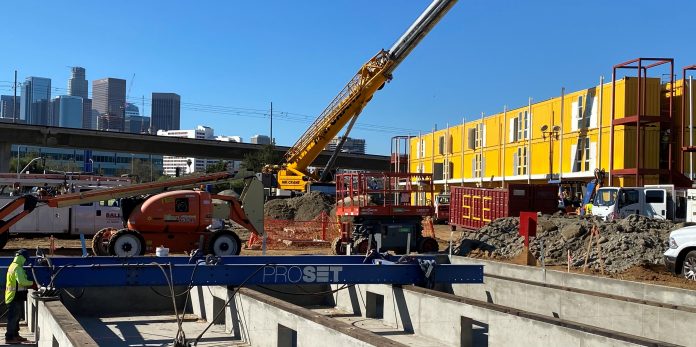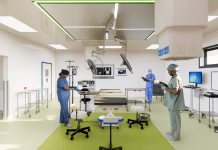Scott Bridger, co-founder of modular installation subcontracting company ProSet Inc, takes a look at how the setting process differs for steel and wood modules
Scott Bridger has worked in construction for his whole career. He was a general contractor in conventional construction when he first met Matt Mitchell in their hometown, Telluride, Colorado. Mitchell had been working in modular construction for more than 25 years. In 2014, the pair founded ProSet Inc., a modular installation subcontracting company, “in response to the high demand for larger-scale multi-family and hospitality modular projects.”
Their first project consisted of three modular apartment buildings in North Dakota. After that initial success, “the timing worked out really well for our second project,” Bridger recalls. “It was right when Marriott adopted modular as its preferred way to build. So our second project was Marriott’s first modular hotel — in Folsom, California.”
Since then, ProSet has installed the majority of modular brand hotels in the western United States, including Hilton, IHG (Holiday Inn Express), Choice, and Marriott.
As ProSet grew, Bridger and Mitchell got repeated requests to do full scope general contracting work for modular projects. So they brought on a third partner, Rick Buckendorf, and in 2017 founded a new company, ProSet Construction Inc., to perform general contracting for modular projects.
ProSet Construction works with many different modular manufacturers, including some overseas companies. “The details of a project — its size, the number of stories, the location, and so on — determine who’s the right manufacturer for any particular project,” Bridger says.
Current project
Although ProSet has installed many projects in the hospitality sector, that work is currently slower because of the pandemic. But demand for market-rate multifamily housing as well as for affordable and supportive housing has remained strong.
ProSet was recently hired by Vesta Modular to install the modules for an interim housing project for the formerly homeless in Los Angeles. In addition to Vesta, two other modular manufacturers are involved in the project: Crate, who will be supplying micro units made from converted shipping containers, and Palomar, who will be supplying wood modular units. Guerdon will supply temporary, relocatable units for the project.
“If we’re going to solve the housing crisis in the United States, we need to build more efficiently, and modular is really starting to gain a foothold in affordable and supportive housing,” Bridger says.
“More developers are getting on board with modular earlier in the process and they’re repeating the same type of product. This is how they’re really benefiting from the efficiencies of modular. That progress in the industry right now is exciting.”
But Bridger is quick to emphasise that maximizing efficiency by using repeatable designs doesn’t mean that every building a developer builds looks the same. “It’s very easy to articulate the modules to get stepped building façades, to have different finishes, and so on. But, for efficiency, the design should use mostly straight walls and square corners. But that’s typical of most multi-family designs that are conventionally built anyway. The efficiencies come through rapid repetition, without having to continuously re-design these buildings from scratch.”
It’s not only affordable and supportive housing projects that benefit from the efficiencies of repetition. Hospitality projects can also realise these efficiencies by using a “repeatable prototype” Bridger says. It’s not a problem if a Fairfield Inn in one city looks the same as a Fairfield Inn in another city. In fact, it can be part of a brand’s identity, so that customers come to expect the same type of room, no matter which Fairfield Inn they stay in. And modular lends itself to the typical hotel design with a hotel room on either side of a straight corridor. “I can go into any modern Fairfield Inn and wouldn’t be able to tell the difference between one that was conventionally built and one that used modular construction — except for the noise,” Bridger says. “Modular hotel rooms are much quieter than conventionally built hotel rooms.”
World of Modular presentation
Once he got involved in the industry, Bridger started attending World of Modular. Then ProSet started having a booth at the conference each year. “It’s a really great opportunity to talk to different stakeholders in the industry,” Bridger says.
For the last couple of years, ProSet has been involved in panel discussions and giving presentations. “For us personally, giving presentations is good exposure to potential clients. But the discussions we have also help to advance the industry as a whole.”
Given that one of ProSet’s current projects involves both wood modules and converted shipping containers, it’s especially fitting that Bridger’s World of Modular presentation this year will be about the installation of different types of modules — wood, steel, and shipping containers. Bridger says, “There are important differences between the processes for stacking different types of modules.”
This article was first published in the Modular Building Institute’s Modular Advantage magazine – January/February 2021 Edition.
Zena Ryder
Freelance writer
LinkedIn: Zena Ryder










![[VIDEO] UK-based firm reveals ‘world’s first’ fully AI-driven architectural project Studio Tim Fu has revealed the 'world's first' fully AI-driven architectural project in Slovenia, developing six luxury villas on the Lake Bled Estate](https://www.pbctoday.co.uk/news/wp-content/uploads/2025/03/Interior-1-studio-tim-fu-218x150.gif)



